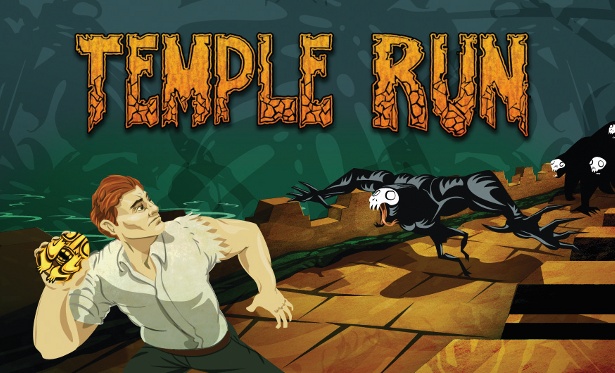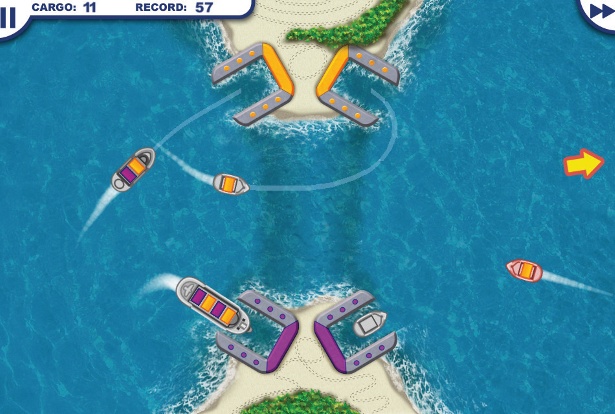Imangi: creating a gaming phenomenon
In four years, Imangi has blossomed from a tiny studio making puzzle games for iPhone to a tiny studio with over 90 million App Store downloads under its belt. So what’s the secret of its success?
It might be a surprise to learn that when husband-and-wife team Keith Shepherd and Natalia Luckyanova founded Imangi – the studio behind App Store phenomenon Temple Run – in 2008, they had no prior experience designing games whatsoever. Although the pair had years of software development experience between them, this largely involved producing web applications for the healthcare industry. So what was it that inspired them to take the App Store by storm?
“We were a bit frustrated with our jobs, and decided we wanted to start our own company and control our own destiny,” begins Shepherd. “I’ve always been a big fan of everything that Apple does, and had an iPhone since the very first day it came out. When Apple announced that you could start building iOS apps, we were very excited and decided to build a company around creating iPhone games.”
While Shepherd and Luckyanova were total rookies in the field, he admits that making games was something of a dream ever since childhood: “When I was young, the reason I got into computers and programming in the first place was because I liked to play games and I wanted to make them,” he shrugs. “So even though we didn’t have much experience, it seemed like a dream come true to be able to start a company doing so.”
It all started with the self-titled word puzzle game, Imangi. “It was a simple but unique game that we created, where you slide rows and columns of letters to form words on a grid,” recalls Shepherd. “Imangi launched on the App Store the day it opened, and even though it wasn’t a runaway success like Temple Run, we proved to ourselves that we could make a living making apps. We’ve been a part of this young market since the beginning, and it’s been an amazing journey to get to where we are today. I definitely didn’t imagine when we first started that we’d make something that could reach over 90 million people.”
Introduced to hungry iOS gamers in August 2011, Temple Run eclipsed long-time App Store darling Angry Birds after six months, as both the number one free app and the top-grossing app of January 2012 – sold for 99 cents at that point, before the game was converted to a freemium model based on in-app purchases of coins to use for upgrades. When it was ported across to Android in March, the freemium version received a staggering million downloads in its first three days in the Market alone.
Nevertheless, iOS remains the studio’s primary concern – and the App Store is certainly where the vast majority of the money is to be made. “The only reason we ported Temple Run to other platforms is because it’s been such a huge success on iOS,” Shepherd points out. “We were getting so many emails from people wanting to play on other platforms that we just couldn’t ignore Android any longer. Pretty much all our recent games are Retina enabled and have Game Center integration, and we use other features as they make sense.”

Despite achieving the kind of success that many established game developers would happily kill for, Imangi has stayed compact – with just one additional staff member, artist Kiril Tchangov, having joined the couple back in 2009.
“As a small team we share a lot of responsibilities, and wear many hats,” he smiles. “In general, Natalia and I run the business, do the programming and the marketing. Natalia also does all of the music for our games and we both share in doing the sound effects. Kiril handles all of the art for our games and is basically responsible for everything looking awesome.”
Imangi has an iterative approach to app development that starts with a kernel of an idea, or in some cases a particular mechanic or feature – and then translates that into a basic prototype quickly to test it out. “Often these prototypes are very ugly and simple, just to prove if something shows promise or not,” explains Shepherd, who believes the key is not to get too bogged down in details during the first few iterations. “Make your prototypes as quick and dirty as possible, and focus on finding the core nugget of fun in whatever you’re trying to build,” he suggests. “If you start with something that’s still fun to play when it’s ugly and rough around the edges, it will be even more amazing when it’s polished and ready for the prime-time.”
The initial Temple Run prototype was built in about a week, recycling the characters and settings from a previous Imangi game, Max Adventure, as a short cut. “We started that project based on the hunt for a better, more natural way to control a character in a 3D environment using only one hand,” recalls Shepherd. From this simple set of experiments, Temple Run’s uniquely compelling, delightfully simple ‘swipe to turn’ mechanic was born.
“Once we had the control mechanic refined, we started thinking about the theme and environment for the game – what type of path would make sense, what type of environment it could be set in and what the game would look like aesthetically,” he continues. “The prototyping phase is very collaborative: all three of us have a lot of input into the ideas and themes. We basically try to get things to a playable and fun state as quickly as we possibly can, and once we’re happy with that, we then move on towards polishing and refining everything. That definitely takes the bulk of the time.”

So from Imangi’s experience, what does it really take to cut through the noise and rocket your game up the App Store rankings? “The iOS market is very crowded and competitive,” warns Shepherd. “It takes a compelling concept that’s extremely well executed and marketed to make something that stands out. One thing that’s extremely important is designing for your device and audience: iOS devices are very unique compared to your traditional gaming console, and you have to make sure that your games are designed around that, instead of shoehorned onto it,” is his advice.
Temple Run’s ultra-convenient one-hand-swipe is a case in point – whether you’re on a busy commuter train, killing time while eating lunch or grabbing some private gaming time on the toilet, it’s all about casual, intuitive and ultimately addictive gameplay. “People are constantly on the go with their devices and they need games that support that,” confirms Shepherd. “The controls need to be so simple to understand that anyone can tell how to play your game within seconds of launching it. Temple Run’s controls are very direct, and it just feels like you’re flicking the character around on the screen to go where you want. It’s a natural fit.”
Another particularly infectious element of an endless runner like Temple Run is the scoring mechanic – which has been tapping into gamers’ competitive streak since videogames were invented. Whether it’s simply a case of challenging yourself to beat your own score, or sharing and comparing them through Game Center, it becomes a key factor in ensuring longevity.
“I think short high-score-driven games are a perfect fit for the on-the-go gamer,” adds Shepherd. “You may only have a few minutes to play here and there throughout the day, so you want an experience that caters to that – something you can pick up and play and have fun with in five-minute chunks.
“Some level-based games can fit that model too, as long as you design the levels to be short, but the reason we prefer endless games that rely more on the underlying mechanic and randomness to level-based games is simply because levelbased games, by definition, have an end. Part of the reason that people keep coming back to Temple Run is because it’s a little different each time.”
Largely due to the nature of the device, casual gamers make up a significant majority of the mobile market – and it’s a conscious decision on Imangi’s part to target them. “For the most part, our games are family friendly and not overly violent,” insists Shepherd. “We try to find people of all ages and demographics to beta test our games: often some of the best feedback we get comes from non-gamers, family and friends.”
For Imangi, there are several possible measures of App Store success – including positive reviews, volume of downloads and revenue generated. Once in a while, a game like Temple Run comes along and ticks all three boxes with aplomb. For now, the freemium model is working well, but the studio remains open-minded in terms of the best approach for making money from iOS games. “I think there’s plenty or room for all types of business models on the App Store,” concludes Shepherd. “You have to pick what will work best: some games just wouldn’t work well as a freemium experience, while others only work as freemium. We experiment with business models almost as much as we experiment with game prototypes.”
Discover the best iPad apps for designers at our sister site, Creative Bloq.
Get the Creative Bloq Newsletter
Daily design news, reviews, how-tos and more, as picked by the editors.

Thank you for reading 5 articles this month* Join now for unlimited access
Enjoy your first month for just £1 / $1 / €1
*Read 5 free articles per month without a subscription

Join now for unlimited access
Try first month for just £1 / $1 / €1

The Creative Bloq team is made up of a group of art and design enthusiasts, and has changed and evolved since Creative Bloq began back in 2012. The current website team consists of eight full-time members of staff: Editor Georgia Coggan, Deputy Editor Rosie Hilder, Ecommerce Editor Beren Neale, Senior News Editor Daniel Piper, Editor, Digital Art and 3D Ian Dean, Tech Reviews Editor Erlingur Einarsson, Ecommerce Writer Beth Nicholls and Staff Writer Natalie Fear, as well as a roster of freelancers from around the world. The ImagineFX magazine team also pitch in, ensuring that content from leading digital art publication ImagineFX is represented on Creative Bloq.
